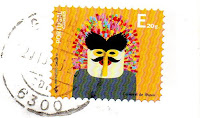Malaysia seems to me a melting pot of cultures that make this country unique. Portuguese, Dutch, British and without forgetting the original Malaysian, all with contributions for the country that we know today.
 |
| Trishaw in Malacca |
This postcard was sent by Bei Hao
Melaka and George Town, historic cities of the Straits of Malacca have developed over 500 years of trading and cultural exchanges between East and West in the Straits of Malacca. The influences of Asia and Europe have endowed the towns with a specific multicultural heritage that is both tangible and intangible. With its government buildings, churches, squares and fortifications, Melaka demonstrates the early stages of this history originating in the 15th-century Malay sultanate and the Portuguese and Dutch periods beginning in the early 16th century. Featuring residential and commercial buildings, George Town represents the British era from the end of the 18th century. The two towns constitute a unique architectural and cultural townscape without parallel anywhere in East and Southeast Asia. - in: http://whc.unesco.org/en/list/1223/
 |
| Porta de Santiago |
This postcard arrived from Portugal and it was sent by Marta
In 1511, a Portuguese fleet arrived under the command of Afonso de Albuquerque. His forces attacked and defeated the armies of the Malacca Sultanate. Moving quickly to consolidate his gains, Albuquerque had the fortress built around a natural hill near the sea. Albuquerque believed that Malacca would become an important port linking Portugal to the Spice Route in China. At this time other Portuguese were establishing outposts in such places as Macau, China and Goa, India to create a string of friendly ports for ships heading to Ming China and returning home to Portugal.
The fortress once consisted of long ramparts and four major towers. One was a four-story keep, while the others held an ammunition storage room, the residence of the captain, and an officers' quarters. Most of the village clustered in town houses inside the fortress walls. As Malacca's population expanded it outgrew the original fort and extensions were added around 1586.
The fort changed hands in 1641 when the Dutch drove the Portuguese out of Malacca. The Dutch renovated the gate in 1670, which explains the logo "ANNO 1670" inscribed on the gate's arch. Above the arch is a bas-relief logo of the Dutch East India Company.
The fortress changed hands again in the late 18th century when the Dutch handed it over to the British to prevent it from falling into the hands of Napoleon's expansionist France. The English were wary of maintaining the fortification and ordered its destruction in 1806. The fort was almost totally demolished but for the timely intervention of Sir Stamford Raffles, the founder of modern Singapore, who happened to visit Malacca in 1810. Because of his passion for history, this small gate was spared from destruction. - in: wikipedia
 |
| Trishaw in George Town, Penang |
George Town is the capital city of the Malaysian state of Penang, located on the north-east corner of the island.
As the Dutch East India Company had dominated the Far East spice trade, the British were determined to establish their presence in the region to control the trade route between mainland China and the Indian subcontinent through the archipelago, and to set up a base to repair British Navy ships. Because of this, Francis Light, who was a captain and a trader for the British East India Company (EIC) was instructed by his company, Jourdain Sullivan and de Souza in Madras,India to establish trade relations in the Malay archipelago. He arrived on Penang Island on 17 July 1786.
As Penang was still under the control of the Sultan of Kedah, Light needed to negotiate with the Sultan Abdullah Mukarram Shah to grant the island to the EIC in exchange for protection of the Sultanate against Siamese and Burmese intrusions. (...) The Sultan was aware that he needed an agreement with the British for protection from the Siamese although he did not realise Light had acted without the approval of his superiors. Following the sealing of agreements by both sides, Light returned to the island on 11 August 1786 to establish possession under the flag of the United Kingdom, and renamed it Prince of Wales Island after George III who later became the King of the United Kingdom.
At the time of his arrival, the island was inhabited by at least 1,000 Malay fishermen. He then built Fort Cornwallis which became the first British presence in the Malay archipelago. - in: wikipedia



No comments:
Post a Comment